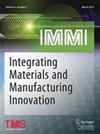添加剂搅拌摩擦沉积修复高强铝合金疲劳行为的多物理场预测
IF 2.5
3区 材料科学
Q3 ENGINEERING, MANUFACTURING
Integrating Materials and Manufacturing Innovation
Pub Date : 2023-11-01
DOI:10.1007/s40192-023-00309-3
引用次数: 0
摘要
摘要采用搅拌摩擦沉积(AFSD)修复过程的光滑颗粒流体动力学(SPH)模拟,为预测高强度铝合金的疲劳寿命提供了多物理场方法。AFSD工艺是一种固态逐层增材制造方法,其中包含原料的中空工具用于沉积材料。虽然了解不断变化的微观结构对于预测材料性能是必要的,但与严重塑性变形过程(SPDP)相关的高温和应变速率使得在AFSD内准确收集实验数据变得困难。由于无法通过实验确定AFSD过程中的材料历史,因此采用SPH模型来预测热力学历史。AFSD修复的SPH模拟被用来为几个微观结构模型提供信息,以预测AFSD加工期间和之后的材料历史以及后处理热处理。然后将这些微观结构模型用于建立机械微观结构和性能模型,以预测AA7075中AFSD修复的疲劳寿命。本文章由计算机程序翻译,如有差异,请以英文原文为准。

Multi-physics Approach to Predict Fatigue Behavior of High Strength Aluminum Alloy Repaired via Additive Friction Stir Deposition
Abstract A smooth particle hydrodynamic (SPH) simulation of an additive friction stir deposition (AFSD) repair was used to inform a multi-physics approach to predict the fatigue life of a high strength aluminum alloy. The AFSD process is a solid-state layer-by-layer additive manufacturing approach in which a hollow tool containing feedstock is used to deposit material. While an understanding of the evolving microstructures is necessary to predict material performance, the elevated temperatures and strain rates associated with severe plastic deformation processes (SPDP) make accurate collection of experimental data within AFSD difficult. Without the ability to experimentally determine material history within the AFSD process, an SPH model was employed to predict the thermomechanical history. The SPH simulation of an AFSD repair was used to inform several microstructural models to predict material history during and after processing with AFSD and a post-processing heat treatment. These microstructure models are then used to inform a mechanistic microstructure and performance model to predict the fatigue life of an AFSD repair in AA7075.
求助全文
通过发布文献求助,成功后即可免费获取论文全文。
去求助
来源期刊

Integrating Materials and Manufacturing Innovation
Engineering-Industrial and Manufacturing Engineering
CiteScore
5.30
自引率
9.10%
发文量
42
审稿时长
39 days
期刊介绍:
The journal will publish: Research that supports building a model-based definition of materials and processes that is compatible with model-based engineering design processes and multidisciplinary design optimization; Descriptions of novel experimental or computational tools or data analysis techniques, and their application, that are to be used for ICME; Best practices in verification and validation of computational tools, sensitivity analysis, uncertainty quantification, and data management, as well as standards and protocols for software integration and exchange of data; In-depth descriptions of data, databases, and database tools; Detailed case studies on efforts, and their impact, that integrate experiment and computation to solve an enduring engineering problem in materials and manufacturing.
 求助内容:
求助内容: 应助结果提醒方式:
应助结果提醒方式:


